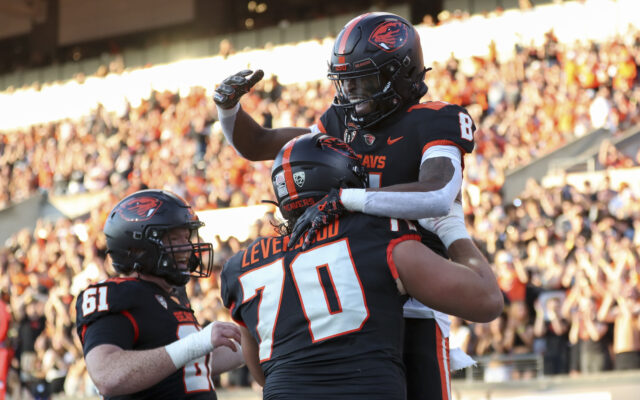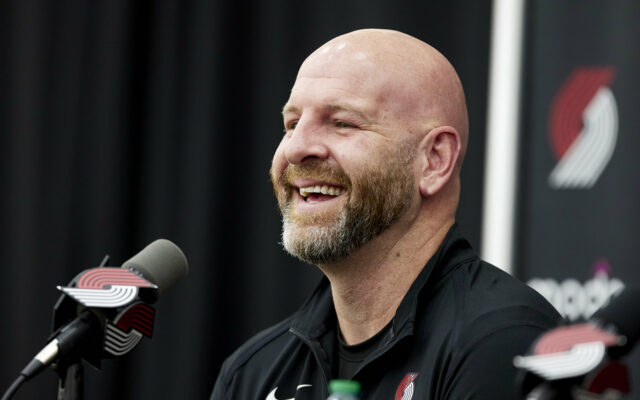Will Deandre Ayton Be The Future Starting Center For The Portland Trail Blazers?

Patrick Rogers | Oregon Sports News
Deandre Ayton joined the Portland Trail Blazers in the offseason via a three-way trade between the Bucks, Suns, and the Blazers. The Blazers front office intended to bring in younger players to develop and retool the team, with team legend Damian Lillard being sent to Milwaukee to acquire Ayton. Pairing Ayton with Shaedon Sharpe, newly drafted Scoot Henderson, and other younger players creates excitement and uncertainty about how the Blazers will develop, making them a must-watch every night. Considering the caliber of players dealt for Ayton, let’s review if he will be the long-term center for the Portland Trail Blazers.
Play Style
Deandre Ayton is your typical pick-and-roll center. A player’s role in that position is to set the screen on a pick and roll, then dive to the basket after creating contact with the opposing player. This creates an open look for the ball handler if both players drop to cover the center, an open look for the center if the screened player falls over, or if both defenders step up to take the open shot away from the ball handler. While Ayton scores the fifth-highest roll-man possessions (4.2 per game) and the sixth-highest points as the roll-man (4.7 per game), he ranks in the 48th percentile for effectiveness. On the flip side, covering the pick and roll is a significant weakness for Ayton. Players rolling into Ayton score 52.9% of the time, with an effective field goal percentage of 63.3%, which puts him in the 18th percentile. This leaderboard area is typically reserved for smaller guards like Coby White, CJ McCollum, and Kevin Huerter, not a seven-foot-tall center.
Another area Ayton scores in is being the cut man. This is similar to a pick and roll, where, as the roll man, you dive to the basket. The difference here is the player is just running to the rim without screening a player, meaning they’re typically taking those shots as close as possible. Ayton does this about 17% of the time and averages about two field goals per game. That would put him in the middle of the pack for centers. The unfortunate thing is he could be more efficient. Ayton ranks near the bottom third of the league in effective field goal percentage at 58.5% and finishes in the 18th percentile.
It’s not all bad for Ayton offensively. The other frequent area Ayton visits is grabbing and putting back offensive boards. Ayton is super efficient at this, with an effective field goal percentage of 66.7%, putting him in the top 10% of the league. He’s also 11th in the league at attempts at 1.8 per game, so he’s active on the offensive boards. Ayton ranks in the top 13% of the league for effectiveness at putbacks.
Potential Growth
When I analyze any NBA player, I always start with free throws. This is the foundation of a player’s success in the league. A decent free throw shooter, say 85%, should utilize this skill to get about four or five points per game. The difference between a 12.5-point-per-game player and a 17.5-point-per-game player could be the difference between a bench player and a starter. Deandre Ayton, this year specifically, seems allergic to contact. He’s averaging a career-low 1.3 free throw attempts per game. His career average is similar at 2.5 per game. Why am I bringing this up in this section? To progress as an NBA player, you must add skills to your repertoire to keep your opponents on their toes. As mentioned above, Ayton rolls to the rim, cuts to the basket, and gets offensive boards. This is great, but these skills peak at some point; ask fellow rim-crasher DeAndre Jordan. Once the athleticism goes, you’re left with a husk of an NBA player and become just a big body on the court. Ayton can add another three or four points per game at the line by being more physical or getting opponents off balance, which is not happening this year.
The other growth opportunity is jump shooting. Ayton uses a mid-range jumper occasionally, but it’s always at the top of the key. He’s also shooting that jumper at about 40%, where the league average is roughly 46%. What’s eluded Ayton for his career as well is a three-point shot. He’s yet to attempt one this year, and to stay in this league, he will need to unveil that at some point. While Ayton’s play style was great about 15 years ago, it will not keep him in the league for long.
Contract Status
Deandre Ayton signed a four-year deal with the Phoenix Suns last year worth over $132 million. This would end after the 2025-2026 season, which falls in line with other players on the Blazers (Jerami Grant and Anfernee Simons). You can bet that this was on purpose by the Blazers management. The line of thinking would be to let the young guns mesh for three years to see where they can go. With aging superstars in the West, such as LeBron James and Steph Curry, there might be an opportunity to be competitive by the end of those contracts.
However, Ayton carries baggage with that contract. Back in 2019, Ayton was suspended under the NBA’s drug program for testing positive for a diuretic. Full disclosure: I’m not a doctor, so I did have to look this up. Essentially, it reduces fluid buildup in the body. Athletes use these in many ways, from losing weight to shedding the presence of other substances. On top of the 25-game suspension, Ayton has also had multiple rumors about his negative locker room presence and attitude among teammates.
On top of the massive contract, there is a staggering amount of center talent whose contracts are simultaneously up at the same time as Ayton’s. Here’s a quick list of centers that will be available as unrestricted free agents (minus any contract extensions that may happen): Rudy Gobert, Bam Adebayo, Jarrett Allen, Jusuf Nurkic, Mitchell Robinson, Wendell Carter, Naz Reid, Daniel Gafford, and Nick Richards. Regarding impact with their team this year, I rate Ayton only ahead of Wendell Carter, mainly because of the contract that Ayton is currently signed. Let’s make a quick comparison to Daniel Gafford. Gafford’s per 36-minute stats put him around 15 points and 11 rebounds with 3.7 free throw attempts per game, whereas Ayton is averaging 16 points and 12 rebounds on 1.3 free throw attempts per game. The biggest discrepancy? Gafford is making $12.4 million this year compared to Ayton’s $32.4 million.
Will Ayton Be The Future Center?
In evaluating Deandre Ayton’s future with the Portland Trail Blazers, it’s clear that his performance and potential growth are under the microscope. While his prowess in certain areas is evident, his overall effectiveness and adaptability to the evolving NBA landscape raise questions. The length of Ayton’s contract aligns with the Blazers’ timeline to cultivate a competitive team with their young core, yet his on-court impact and off-court actions leave me questioning if he’s worth it. As the league’s center talent evolves, Ayton’s ability to expand his game and positively influence team dynamics will be crucial in determining if he genuinely is the long-term solution for Portland. Still, other, less expensive players are producing just as much as he is currently. If this doesn’t change soon, the Blazers must move on Ayton quickly. Because of everything I mentioned above, I would move on from Ayton. The contract isn’t worth the current talent level.








